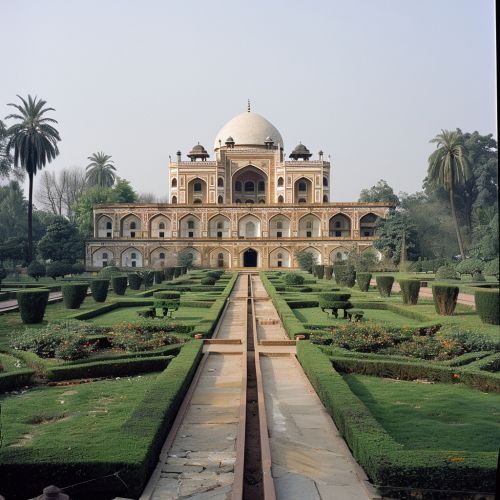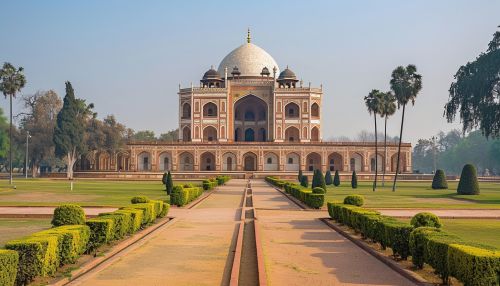Humayun: Difference between revisions
(Created page with "== Early Life and Background == Nasir-ud-Din Muḥammad, more commonly known as Humayun, was born on March 6, 1508, in Kabul, Afghanistan. He was the eldest son of Babur, the founder of the Mughal Empire, and his wife Maham Begum. Humayun's early life was marked by a rigorous education in various fields, including military strategy, administration, and the arts. His upbringing was influenced by the cultural and intellectual milieu of the Timurid court, which was kno...") |
No edit summary |
||
| Line 23: | Line 23: | ||
Humayun's reign saw significant contributions to Mughal architecture, most notably the construction of Humayun's Tomb in Delhi. This mausoleum, commissioned by his widow, Bega Begum, is considered a precursor to the later architectural masterpieces of the Mughal era, such as the [[Taj Mahal]]. The tomb is characterized by its Persian-inspired design, featuring a large central dome, intricate tile work, and extensive gardens. | Humayun's reign saw significant contributions to Mughal architecture, most notably the construction of Humayun's Tomb in Delhi. This mausoleum, commissioned by his widow, Bega Begum, is considered a precursor to the later architectural masterpieces of the Mughal era, such as the [[Taj Mahal]]. The tomb is characterized by its Persian-inspired design, featuring a large central dome, intricate tile work, and extensive gardens. | ||
[[Image:Detail-92283.jpg|thumb|center|Humayun's Tomb in Delhi, India, with its Persian-inspired architecture and extensive gardens.|class=only_on_mobile]] | |||
[[Image:Detail-92284.jpg|thumb|center|Humayun's Tomb in Delhi, India, with its Persian-inspired architecture and extensive gardens.|class=only_on_desktop]] | |||
== Legacy and Death == | == Legacy and Death == | ||
Latest revision as of 07:55, 15 June 2024
Early Life and Background
Nasir-ud-Din Muḥammad, more commonly known as Humayun, was born on March 6, 1508, in Kabul, Afghanistan. He was the eldest son of Babur, the founder of the Mughal Empire, and his wife Maham Begum. Humayun's early life was marked by a rigorous education in various fields, including military strategy, administration, and the arts. His upbringing was influenced by the cultural and intellectual milieu of the Timurid court, which was known for its patronage of the arts and sciences.
Ascension to the Throne
Humayun ascended to the throne in December 1530, following the death of his father, Babur. His accession was not without challenges, as he had to contend with the ambitions of his brothers and the political instability of the newly established Mughal Empire. Humayun's reign began with the consolidation of power and the suppression of internal revolts, particularly those led by his brothers, Kamran, Askari, and Hindal.
Military Campaigns and Challenges
Humayun's reign was characterized by a series of military campaigns aimed at expanding and consolidating the Mughal Empire. One of his earliest challenges was the threat posed by the Afghan chieftain Sher Shah Suri. Sher Shah's military prowess and strategic acumen led to a series of defeats for Humayun, culminating in the Battle of Chausa in 1539 and the Battle of Kanauj in 1540. These defeats forced Humayun into exile, marking a significant setback in his reign.
Exile and Return
Following his defeat at the hands of Sher Shah Suri, Humayun sought refuge in the court of the Safavid ruler, Shah Tahmasp I, in Persia. During his exile, Humayun forged a strategic alliance with the Safavids, which would later prove crucial in his efforts to reclaim his throne. With Persian support, Humayun launched a campaign to retake his lost territories, eventually succeeding in 1555 after the death of Sher Shah Suri and the subsequent decline of the Suri dynasty.
Administrative Reforms
Upon his return to power, Humayun implemented a series of administrative reforms aimed at stabilizing and strengthening the Mughal Empire. These reforms included the reorganization of the provincial administration, the establishment of a centralized revenue system, and the promotion of trade and commerce. Humayun also placed a strong emphasis on the patronage of the arts and sciences, fostering a cultural renaissance that would later flourish under his son, Akbar the Great.
Architectural Contributions
Humayun's reign saw significant contributions to Mughal architecture, most notably the construction of Humayun's Tomb in Delhi. This mausoleum, commissioned by his widow, Bega Begum, is considered a precursor to the later architectural masterpieces of the Mughal era, such as the Taj Mahal. The tomb is characterized by its Persian-inspired design, featuring a large central dome, intricate tile work, and extensive gardens.


Legacy and Death
Humayun's legacy is a complex one, marked by both his military setbacks and his contributions to the cultural and administrative foundations of the Mughal Empire. Despite the challenges he faced, Humayun's efforts to consolidate and expand the empire laid the groundwork for the subsequent successes of his son, Akbar. Humayun died on January 27, 1556, after a fall from the stairs of his library in Delhi. His death marked the end of a tumultuous yet pivotal chapter in the history of the Mughal Empire.
